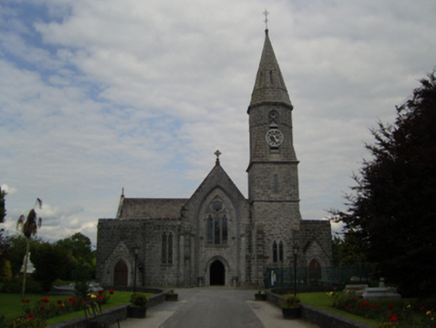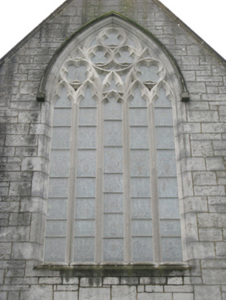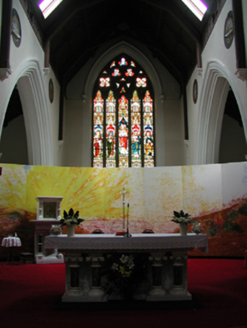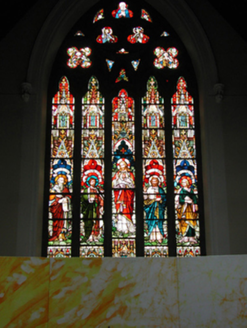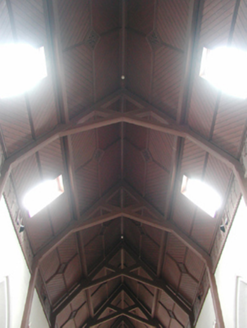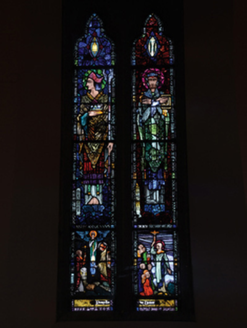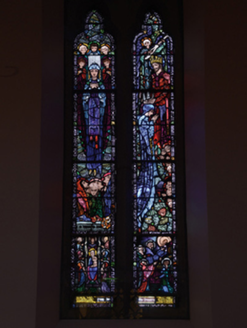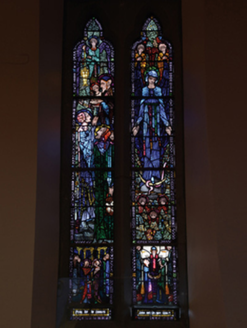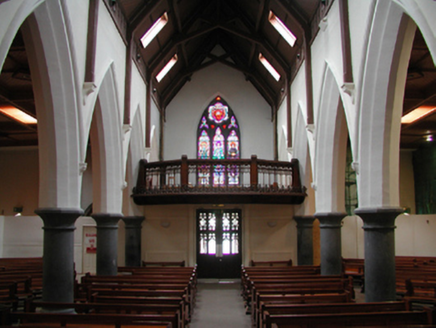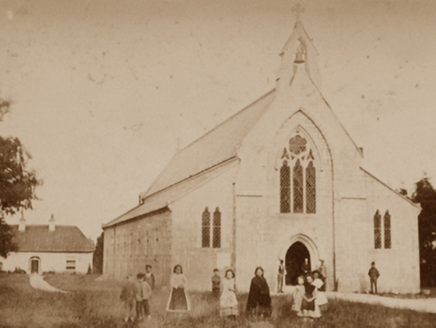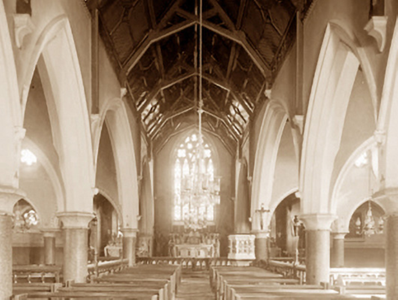Survey Data
Reg No
31215035
Rating
National
Categories of Special Interest
Architectural, Artistic, Historical, Social, Technical
Original Use
Church/chapel
In Use As
Church/chapel
Date
1845 - 1865
Coordinates
119189, 264234
Date Recorded
25/11/2010
Date Updated
--/--/--
Description
Detached six-bay double-height Catholic church, begun 1849; unfinished 1854; completed 1859; dedicated 1863, on a cruciform plan originally eight-bay double-height on a rectangular plan comprising four-bay double-height nave opening into four-bay double-height flat-roofed side aisles with single-bay (two-bay deep) double-height transepts centred on single-bay double-height chancel to crossing (east); single-bay three-stage tower (south-west) on a square plan supporting octagonal spire. Extended, 1888. "Improved", 1895. Extended, 1923-4, producing present composition. Renovated, 1967, with sanctuary reordered. Undergoing "restoration", 2010-1. Interior including vestibule (west); square-headed door opening into nave with glazed timber panelled double doors; full-height interior open into roof undergoing "restoration", 2010-1, with Gothic-style timber panelled organ gallery (west) on a half-octagonal plan supporting timber panelled pipe organ centred on stained glass memorial "West Window" (1930), carpeted central aisle between timber pews, pointed-arch arcades on dragged limestone ashlar pillars with hood mouldings on portrait label stops, carpeted stepped dais to sanctuary (east) reordered, 1967, with cut-veined white marble Classical-style altar below stained glass memorial "East Window" (1883), exposed scissor truss timber roof construction on dragged cut-limestone "Cavetto" corbels with wind braced diagonal timber boarded or tongue-and-groove timber panelled ceiling in carved timber frame on arcaded frieze on chevron- or saw tooth-detailed cornice, pair of cut-white marble wall monuments (ob. 1874; 1872), and replacement timber stations to side aisles between stained glass memorial windows (1925; "restored" 1989). Set back from street in landscaped grounds with cast-iron chamfered piers to perimeter having capping supporting "Fleur-de-Lys"-detailed cast-iron double gates.
Appraisal
A church begun (1849) to a design by Richard Pierce (1801-54) representing an important component of the built heritage of south County Mayo with the architectural value of the composition, one originally evoking strong comparisons with the Augustus Welby Northmore Pugin (1812-52)-designed Catholic Church of the Blessed Virgin Mary and Saint Alphonsus Liguori (1844-8) in County Wexford, confirmed by such attributes as the cruciform plan form, aligned along a liturgically-correct axis; the construction in a "sparrow pecked" limestone offset by sheer dressings demonstrating good quality workmanship; the slender profile of the coupled openings underpinning a 'very hard French Gothic' theme (Craig and Garner 1976, 9) with the chancel defined by a cusped "East Window" remodelled to a design signed (1859) by William George Murray (1822-71) of Dublin (DIA); and the polygonal spire-topped tower dominating the skyline as a picturesque eye-catcher in the landscape: meanwhile, aspects of the composition clearly illustrate the continued development of the church into the twentieth century with those works including "improvements" completed to designs by Rudolph Maximilian Butler (1872-1943) of Kildare Street, Dublin (Irish Builder 19th May 1923, 380). Having been well maintained, the elementary form and massing survive intact together with substantial quantities of the original fabric, both to the exterior and to the interior reordered (1967) in accordance with the liturgical reforms sanctioned by the Second Ecumenical Council of the Vatican (1962-5) where the so-called "D'Alton Windows" supplied (1925) by Harry Clarke (1889-1931) of Dublin; and the later "West Window" supplied (1930) by Harry Clarke Stained Glass Studios (closed 1973) of Dublin to a design originally intended for Saint Peter's Catholic Church in Phibsboro (Staunton 2013, 11), all highlight the considerable artistic importance of the composition: meanwhile, an exposed timber roof construction pinpoints the engineering or technical dexterity of a church forming part of a self-contained group alongside an adjacent presbytery (see 31215036) and parochial house (see 31215037) with the resulting ecclesiastical ensemble making a pleasing visual statement in Main Street.



